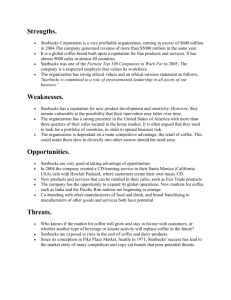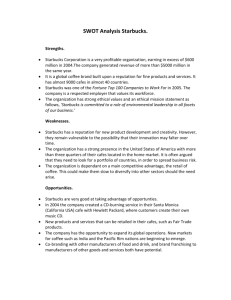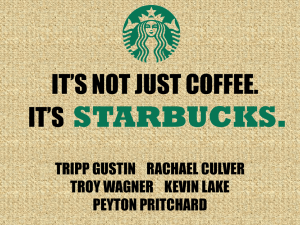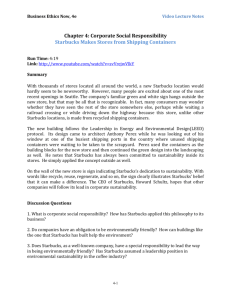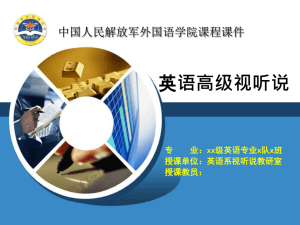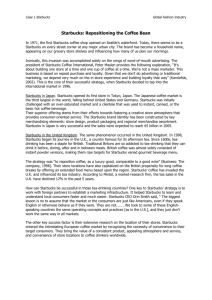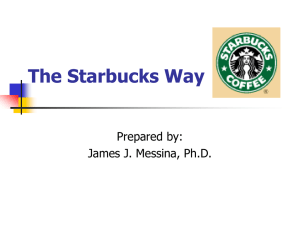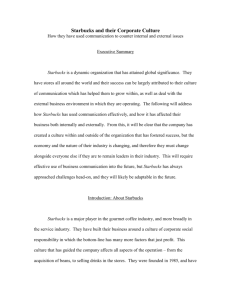Starbucks
advertisement
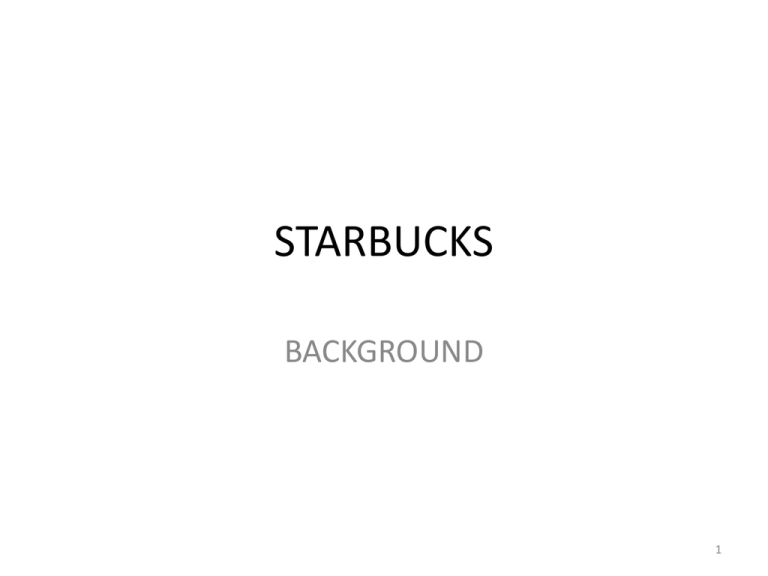
STARBUCKS BACKGROUND 1 STARBUCKS • STARBUCKS WAS A SINGLE STORE IN SEATTLE’S PICE PLACE MARKET SELLING PREMIUM-ROASTED COFFEE THIRTY YEARS AGO. • TODAY IT IS A GLOBAL ROASTER AND RETAILER OF COFFEEE WITH SOME 17,700 STORES, 40% OF WHICH ARE IN 50 COUNTRIES OUTSIDE THE UNITED STATES. • STARBUCKS SET OUT ON ITS CURRENT COURSE IN THE 1980s WHEN THE COMPANY’S DIRECTOR OF MARKETING, HOWARD SCHULTZ, CAME BACK FROM A TRIP TO ITALY ENCHANTED WITH THE ITALIAN COFFEEEHOUSE EXPERIENCE. 2 Starbucks Schultz, who later became CEO, persuaded the company’s owner to experiment with the coffehouse format—and Starbucks was born. Strategy Sell company’s own premium-roasted coffee and freshly brewed expresso-style coffee beverages, along with a variety of pastries, coffee accessories, teas, and other products, in a tastefully designed coffeeehouse setting. 3 Starbucks • The company focussed on selling a “third place” Experience, rather than just the coffee. • Led to spectacular success in the United states, where Starbucks went from obscurity to one of the best-known brands in the country in a decade. • Coffee stores became places for relaxation, chatting with friends, reading the newspapers, holding business meetings, or (more recently) browsing the web. 4 Starbucks • The first target outside the United States was Japan. • Established a joint venture with a retailer, Sazaby Inc.; with a 50 percent stake in the venture, Starbucks Coffeee of Japan. • Invested $ 10 milliion • Licensed the venture, charged with taking over responsibility for growing Starbucks’ presence in Japan 5 Starbucks • Training to japanese employees similar to those give to U.S. employees • Stock option plan for all Japanese employees • By the end of 2009—850 stores and a profitable business in Japan • 1998—purchased Seattle Coffee, a British coffee chain with 60 retail stores, for $ 84 million • In late 1990s– opened stores in Taiwan, China, Singapore, Thailand, New Zealand, South Korea, and Malaysia. 6 Starbucks Strategy in Asia—license its format to a local operator in return for initial licensing fees and royalties on store revenue. • 2002—aggressive expansion in Europe; Switzerland to start with followed by other countries • Joint venture with Bon Appetot Group, largest food service company 7 Starbucks Ethical Policy: Environmental Responsibility • Fair Trade Certified Coffeee • Empower small-scale farmers organized in cooperatives, develop skills necessary to compete in the global market place • 2010—some 75% of the coffee Starbucks purchased was Fair Trade Certified, and the company has a goal of increasing that to 100% by 2015 8
